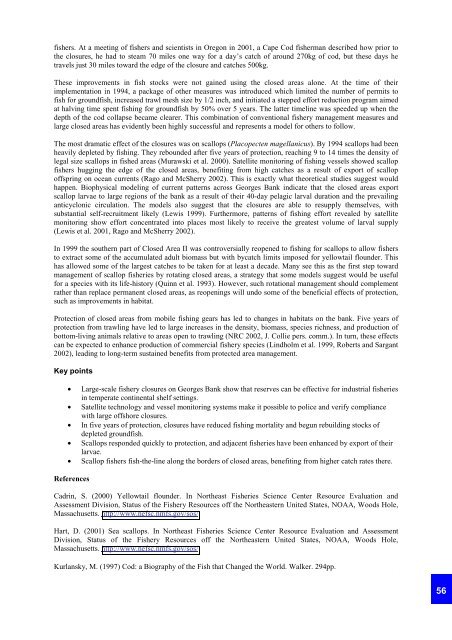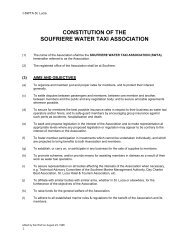WWF Cover photo - Soufriere Marine Management Association ...
WWF Cover photo - Soufriere Marine Management Association ...
WWF Cover photo - Soufriere Marine Management Association ...
You also want an ePaper? Increase the reach of your titles
YUMPU automatically turns print PDFs into web optimized ePapers that Google loves.
fishers. At a meeting of fishers and scientists in Oregon in 2001, a Cape Cod fisherman described how prior tothe closures, he had to steam 70 miles one way for a day’s catch of around 270kg of cod, but these days hetravels just 30 miles toward the edge of the closure and catches 500kg.These improvements in fish stocks were not gained using the closed areas alone. At the time of theirimplementation in 1994, a package of other measures was introduced which limited the number of permits tofish for groundfish, increased trawl mesh size by 1/2 inch, and initiated a stepped effort reduction program aimedat halving time spent fishing for groundfish by 50% over 5 years. The latter timeline was speeded up when thedepth of the cod collapse became clearer. This combination of conventional fishery management measures andlarge closed areas has evidently been highly successful and represents a model for others to follow.The most dramatic effect of the closures was on scallops (Placopecten magellanicus). By 1994 scallops had beenheavily depleted by fishing. They rebounded after five years of protection, reaching 9 to 14 times the density oflegal size scallops in fished areas (Murawski et al. 2000). Satellite monitoring of fishing vessels showed scallopfishers hugging the edge of the closed areas, benefiting from high catches as a result of export of scallopoffspring on ocean currents (Rago and McSherry 2002). This is exactly what theoretical studies suggest wouldhappen. Biophysical modeling of current patterns across Georges Bank indicate that the closed areas exportscallop larvae to large regions of the bank as a result of their 40-day pelagic larval duration and the prevailinganticyclonic circulation. The models also suggest that the closures are able to resupply themselves, withsubstantial self-recruitment likely (Lewis 1999). Furthermore, patterns of fishing effort revealed by satellitemonitoring show effort concentrated into places most likely to receive the greatest volume of larval supply(Lewis et al. 2001, Rago and McSherry 2002).In 1999 the southern part of Closed Area II was controversially reopened to fishing for scallops to allow fishersto extract some of the accumulated adult biomass but with bycatch limits imposed for yellowtail flounder. Thishas allowed some of the largest catches to be taken for at least a decade. Many see this as the first step towardmanagement of scallop fisheries by rotating closed areas, a strategy that some models suggest would be usefulfor a species with its life-history (Quinn et al. 1993). However, such rotational management should complementrather than replace permanent closed areas, as reopenings will undo some of the beneficial effects of protection,such as improvements in habitat.Protection of closed areas from mobile fishing gears has led to changes in habitats on the bank. Five years ofprotection from trawling have led to large increases in the density, biomass, species richness, and production ofbottom-living animals relative to areas open to trawling (NRC 2002, J. Collie pers. comm.). In turn, these effectscan be expected to enhance production of commercial fishery species (Lindholm et al. 1999, Roberts and Sargant2002), leading to long-term sustained benefits from protected area management.Key points• Large-scale fishery closures on Georges Bank show that reserves can be effective for industrial fisheriesin temperate continental shelf settings.• Satellite technology and vessel monitoring systems make it possible to police and verify compliancewith large offshore closures.• In five years of protection, closures have reduced fishing mortality and begun rebuilding stocks ofdepleted groundfish.• Scallops responded quickly to protection, and adjacent fisheries have been enhanced by export of theirlarvae.• Scallop fishers fish-the-line along the borders of closed areas, benefiting from higher catch rates there.ReferencesCadrin, S. (2000) Yellowtail flounder. In Northeast Fisheries Science Center Resource Evaluation andAssessment Division, Status of the Fishery Resources off the Northeastern United States, NOAA, Woods Hole,Massachusetts. http://www.nefsc.nmfs.gov/sos/Hart, D. (2001) Sea scallops. In Northeast Fisheries Science Center Resource Evaluation and AssessmentDivision, Status of the Fishery Resources off the Northeastern United States, NOAA, Woods Hole,Massachusetts. http://www.nefsc.nmfs.gov/sos/Kurlansky, M. (1997) Cod: a Biography of the Fish that Changed the World. Walker. 294pp.56



